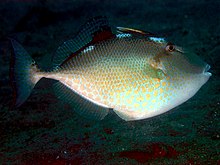Abalistes
| Abalistes | |
|---|---|

| |
| Abalistes stellatus | |
| Scientific classification | |
| Domain: | Eukaryota |
| Kingdom: | Animalia |
| Phylum: | Chordata |
| Class: | Actinopterygii |
| Order: | Tetraodontiformes |
| Family: | Balistidae |
| Genus: | Abalistes D. S. Jordan & Seale, 1906[1] |
| Type species | |
| Leiurus macrophthalmus | |
| Synonyms[2] | |
| |
Abalistes is a small genus of marine ray-finned fishes belonging to the family Balistidae, the triggerfishes. These triggerfishes are found in the Indo-Pacific and eastern Atlantic. This genus contains two recognised species.
Taxonomy
Abalistes was first proposed as a genus in 1906 by the American ichthyologists David Starr Jordan and Alvin Seale with Leiurus macrophthalmus the type species. L. macropthalmus was originally described by William Swainson with Leiurus being proposed as a subgenus of Capriscus, i.e. Balistes, but he used the same name in the same book for a subgenus of the stickleback genus Gasterosteus, meaning that it was unavailable for the triggerfish.[2] This genus belongs to the family Balistidae which is classified within the suborder Balistoidei.[3]
Etymology
Abalistes prefixes a-, meaning "not", with Balistes, the genus that A. stellaris, a synonym of A. stellatus, was considered to belong to.[4]
Species
There are currently two recognised species in this genus:[5]
- Abalistes filamentosus Matsuura & Yoshino, 2004 [6] (Hairfin triggerfish)
- Abalistes stellatus Anonymous, referred to Lacépède, 1798 (Starry triggerfish)
Characteristics
Abalistes triggerfishes are distinguished from the othere triggerfish genera by the morphology of the caudal peduncle which is wider than it is deep, i.e. depressed rather than compressed. They have a terminal mouth with uneven notched teeth.[7] The largest of the two species in the genus is the starry triggerfish (A. stellatus) which has a maximum published total length of 60 cm (24 in), A. filamentosus is much smaller with a maximum published standard length of 32.5 cm (12.8 in).[8]
Distribution
Abalistes triggerfishes are found in the Indo-Pacific from the Red Sea and the eastern coast of Africa east through the Indian Ocean and into the Pacific Ocean north to southern Japan, south to Australia and east to Fiji.[9]
References
- ^ "Genus Abalistes Jordan & Seale 1906". FishWisePro. 1906. Retrieved 16 April 2020.
- ^ a b c Eschmeyer, William N.; Fricke, Ron & van der Laan, Richard (eds.). "Genera in the family Balistidae". Catalog of Fishes. California Academy of Sciences. Retrieved 16 October 2024.
- ^ "Eschmeyer's Catalog of Fishes Classification". Eschmeyer's Catalog of Fishes. California Academy of Sciences. Retrieved 16 October 2024.
- ^ Christopher Scharpf (21 August 2024). "Order TETRAODONTIFORMES: Families MOLIDAE, BALISTIDAE, MONACANTHIDAE, ARACANIDAE and OSTRACIIDAE". Christopher Scharpf. Retrieved 16 October 2024.
- ^ Eschmeyer, William N.; Fricke, Ron & van der Laan, Richard (eds.). "Species in the genus Abalistes". Catalog of Fishes. California Academy of Sciences. Retrieved 16 October 2024.
- ^ Matsuura, K. & Yoshino, T. (2004). "A new triggerfish of the genus Abalistes (Tetraodontiformes: Balistidae) from the western Pacific" (PDF). Records of the Australian Museum. 56 (2): 189–194. Archived 2015-09-25 at the Wayback Machine

- ^ Keiichi Matsuura (2022). "Tetraodontiformes". In Phillip C. Heemstra; Elaine Heemstra; David E. Ebert; Wouter Holleman; John E. Randall (eds.). Coastal Fishes of the Western Indian Ocean (PDF). pp. 406–485.
- ^ Froese, Rainer; Pauly, Daniel (eds.). "Species in genus Abalistes". FishBase. Retrieved 16 October 2024.
- ^ Matsuura, K (2014). "Taxonomy and systematics of tetraodontiform fishes: a review focusing primarily on progress in the period from 1980 to 2014". Ichthyological Research. 62 (1): 72–113. Bibcode:2015IchtR..62...72M. doi:10.1007/s10228-014-0444-5.
